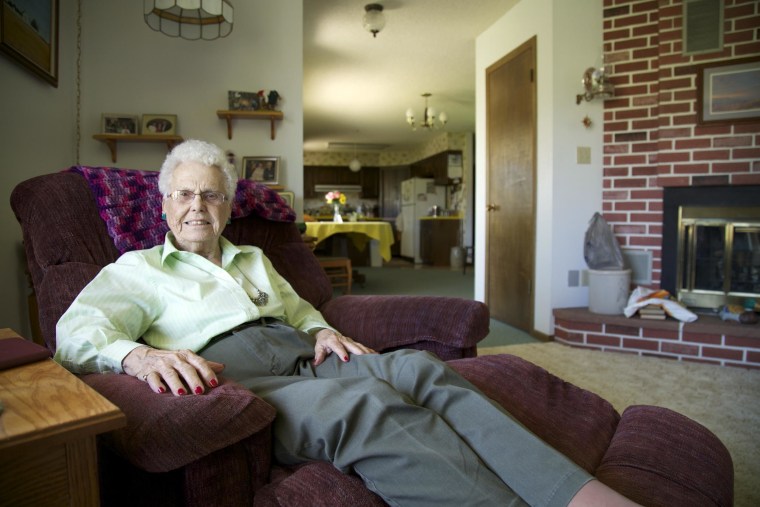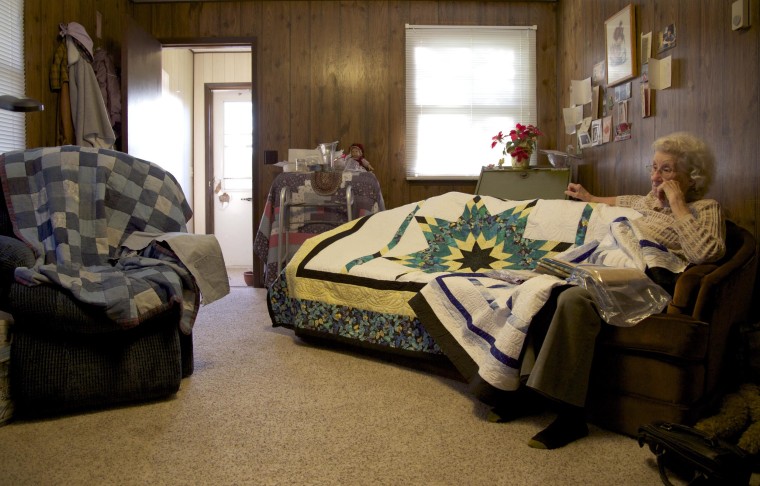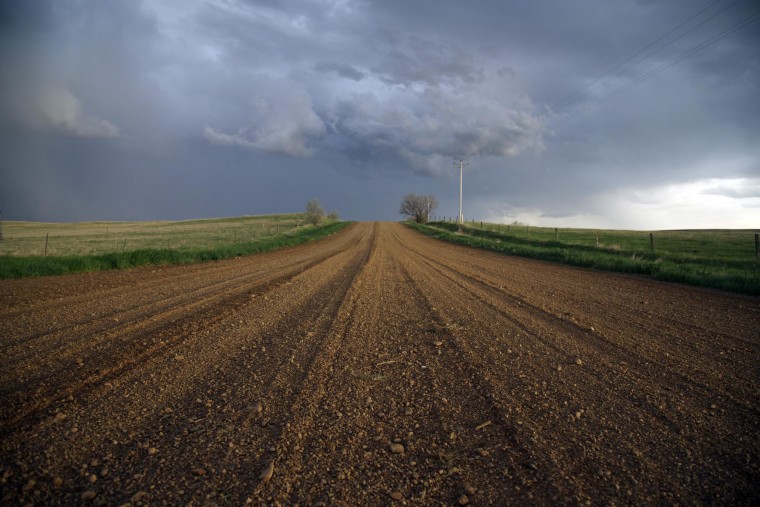NBC News spent a year looking at how Montana is grappling with what the state has dubbed an “aging tsunami.” This article was supported by the Dennis A. Hunt Fund for Health Journalism, a project of California Endowment Health Journalism Fellowships at the USC Annenberg School of Journalism.
This is the first of two parts.
Circle, Montana — There is no part of life in McCone County, Montana, where the community’s age has not begun to show. Farmers have gone gray. There were some dozen funerals last winter. Each year makes more widows.
Nearly 25 percent of McCone County’s 1,700 residents are already over 60, a bellwether for changes that will soon roll across Montana. State projections show a quarter of Montanans will be seniors by 2030, twenty years before the same demographic shift hits the nation as a whole.
Montana policymakers have watched that shift coming toward them, knowing it brings more older, potentially sicker patients to a largely rural medical system in which providers and specialists are already scarce. Seniors here often travel an hour or more for “emergency” care, and nursing home beds are dwindling, particularly in the sparsest areas.
In the face of these changes, Charlie Rehbein, head of the Montana Office on Aging, asks, “How do we provide services to them?”

He’s thinking about people like Gloria Busse. Since her husband passed away nearly 15 years ago, she has lived alone in her spotless one-story house on the edge of Circle, the 600-person town that is the seat of McCone County. Her children relocated hundred of miles away across this vast state years ago. But Busse, now 90, stayed. “This is my home,” she said.
Stretched in a plush recliner in her living room, Busse says that McCone will be okay because people here have long known how to make do. “We've always lived in isolation,” said Busse, waving a red-nailed hand. "From the beginning of time, the pioneers helped each other. This is just a natural thing.”
Some 80 percent of older people want to “age in place,” according to surveys by the AARP. Whether in their longtime house or assisted living in the same area, most want to live out their last days in the community where they spent their best.
Figuring out how to help them do that is not a problem exclusive to Montana. As the U.S. population ages, the demand for care, and the cost of providing it, are expected rise nationwide. But the country’s 812 “frontier” counties of fewer than 20 people per square mile face particular challenges.
The first is distance. Circle is 30 miles from the next incorporated town. Its one-bed emergency room is 50 miles from the next hospital, and 240 miles from the nearest fully equipped hospital with specialists, in Billings. Patients can be rushed by ambulance or plane when time is crucial. But that’s expensive, and doesn’t offer a solution to helping older people with the more quotidian things that keep people well.
"From the beginning of time, the pioneers helped each other. This is just a natural thing.”
"How do they get to the doctor?” Rehbein asked. “Are there people within that community that can be trained up to work with older people, or are they even willing to do this work?”
Like many rural counties throughout the country, McCone is growing older by attrition. Fewer are born there. Those who are often leave and don’t return. Those who remain grow older.
That includes the people who provide the care. Nearly 25 percent of Montana’s physicians are age 60 or over. About 40 percent of its registered nurses have hit 50. So Montana’s seniors need more help — up to 3.5 times more health care services than younger people--but the pool of younger workers to care for them is shrinking.
While this demographic shift was seen a long way down the road, there has been little concentrated effort to grapple with these issues at a national level, said Professor Andrew Coburn of the Maine Rural Health Research Center at the University of Southern Maine.
“Aging is the kind of thing most of us don’t like to think about, so there hasn’t been a lot of policy innovation that has been widely embraced,” said Coburn. Yet failing to create smart policy around aging could have major implications across the country, he said.
It’s most acute in the parts of the Northeast and Mountain West that are simultaneously aging and shrinking.
Experts in rural health believe the answers start in the communities themselves.
For decades now, Montana has been searching for ways to keep care accessible. It was one of the first states to create a Medicaid waiver program in the 1980s. Waivers allow people who need long-term care to use Medicaid funds to be cared for in their community, often by family or friends, rather than in an institution.
It was also one of the first to roll out the model of small, limited-service rural hospitals, now known as Critical Access Hospitals. These have also begun to provide long-term care in areas that have a shortage of nursing home beds.
But Montana needs more.

The number of nursing home beds in the state dropped from nearly 1,850 in 2005 to fewer than 1,400 in 2009 because of regulations that made it harder to keep these homes as part of a hospital. Home health care has dwindled too, from 76 agencies in 2000 to just 42 in 2009 because of payment methods that require a minimum volume to remain viable — one Montana couldn’t meet.
This comes even as the state’s Plan On Aging identified home care and community-based services as some of the key areas the state should grow in order to meet the needs of the “aging tsunami.”
Patti Schipman runs the McCone County Community and Senior Center out of a storefront on Main Street in Circle. There is no in-home care program in the county, so as people grow older, Schipman often reaches out to offer help.
“I can’t have someone there all the time, but I can make sure someone stops by every day,” she said.
On a windy afternoon in late spring, Busse, the 90-year-old widow, had just said goodbye to Sharon Jensen, a public health worker who stops by weekly to check her blood pressure. A homemaker also arrives regularly to help Busse around the house. Still spry, Busse on Fridays drives down to the Senior Center for the weekly midday dinner, subsidized for seniors, and Mondays she might stop by again to join the regulars for Pinochle.
“I feel like I have assisted living,” she said. “Everyone in town helps me.”
“I feel like I have assisted living. Everyone in town helps me.”
That was true even last spring when Busse fell while pulling weeds in her yard. Her arm was broken, and she couldn’t get up, so she lay on the grass out front until a group of young women walked by. One picked her up and took her to the McCone County Health Center, which told her she would have to go two more hours down the highway to Miles City to get the arm seen. The town has no public transport, and because it was no longer an emergency, Busse’s ambulance trip would probably not have been covered. She turned to the young woman who had found her on the lawn.
“I asked her, ‘Will you take me?’ And she did,’” Busse said. “This is being in a small town in Montana.”
And therein lies the rub. While Circle sits far from many health care services, it’s a good place to age. Old ranchers and farmers drive into town for coffee and gossip once, sometimes twice a day. If a regular lady does not show up at the Friday senior lunch, or a man for his afternoon drink, people notice. Here in the places that feed the country, where wheat and cattle are raised up and sent to markets East and West, ties still bind.
The pioneer spirit has made many in these communities uninclined to demand government resources, yet figuring out policies to help to keep these people, and these places, healthy is “an issue of fairness,” said Brad Gibbens, deputy director of the Center For Rural Health at the University of North Dakota. “We’re all Americans. We’re all citizens. We all have certain rights and expectations of the availability and quality of our education, housing and health care systems.”
McCone takes care of its own, but even Busse knows that should she need more help, she might not be able to stay. And while she approaches this subject with the same straight spine as everything else — she is, after all, Montanan — that would change everything. “I've never lived anywhere but in McCone County,” she said.
